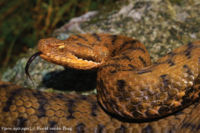Members are usually small and more or less stoutly
built. The head is distinct from the neck and covered
with small scales in many species, although some have a
few small plates on top. The dorsal scales are strongly
keeled, the anal scale is divided and the subcaudals
paired.[2]
They can be found in
Great Britain and nearly all of continental Europe, on
some small islands of the Mediterranean (Elba,
Montecristo, Sicily) and the Aegean Sea, as well as in
northern Africa in Morocco, Algeria and Tunisia. It also
occurs across the Arctic Circle and eastwards though
northern Asia to Sakhalin Island and northern Korea.
[1]
Most species prefer cooler environments. Those found
at lower latitudes tend to prefer higher altitudes and
dryer, rocky habitats, while the species that occur at
more northern latitudes prefer lower elevations and
environments that have more vegetation and moisture.[2]
| Species[1] |
Subsp.* |
Common name |
Geographic range[1] |
|
V. albicornuta |
0 |
Iranian mountain viper |
The Zanjan Valley and
surrounding mountains in northwestern Iran. |
|
V. albizona |
0 |
Central Turkish mountain viper |
Central
Turkey. |
|
V. ammodytes |
4 |
Horned viper |
North-eastern Italy, southern Slovakia,
western Hungry, Slovenia, Croatia,
Bosnia-Herzegovina, Serbia, Montenegro, Albania,
Greece (including Macedonia and Cyclades),
Romania, Bulgaria, Turkey, Georgia and Syria. |
|
V. aspisT |
4 |
Asp viper |
France, Andorra, northeastern Spain, extreme
southwestern Germany, Switzerland, Monaco, the
islands of Elba and Montecristo, Sicily, Italy,
San Marino and northwestern Slovenia. |
|
V. barani |
0 |
Baran's adder |
Northwestern Turkey. |
|
V. berus |
2 |
Common European adder |
From western Europe (Great Britain,
Scandinavia, France) across central (Italy,
Albania, Bulgaria and northern Greece) and
eastern Europe to north of the Arctic Circle,
and Russia to the Pacific Ocean, Sakhalin
Island, North Korea, northern Mongolia and
northern China. |
|
V. bornmuelleri |
0 |
Bornmuellers viper |
Golan Heights, southern Lebanon and Syria. |
|
V. bulgardaghica |
0 |
Bulgardagh viper |
The Bulgar Dagh (Bolkar Dagi) mountains,
Nigde Province, south central Anatolia, Turkey. |
|
V. darevskii |
0 |
Darevsky's viper |
The southeastern Dzavachet Mountains in
Armenia and adjacent areas in Georgia. |
|
V. dinniki |
0 |
Dinnik's viper |
Russia (Great Caucasus) and Georgia (high
mountain basin of the Inguri River), eastward to
Azerbaijan. |
|
V. kaznakovi |
0 |
Caucasus viper |
Northeastern Turkey, Georgia and Russia
(eastern Black Sea coast. |
|
V. latastei |
1 |
Lataste's viper |
Extreme southwestern
Europe (France, Portugal and Spain) and
northwestern Africa (the Mediterranean region of
Morocco, Algeria and Tunisia). |
|
V. latifii |
0 |
Latifi's viper |
Iran: upper Lar Valley in the Elburz
Mountains. |
|
V. lotievi |
0 |
Caucasian meadow viper |
The higher range of the Big Caucasus: Russia, Georgia and
Azerbaijan. |
|
V. monticola |
0 |
Atlas mountain viper |
High Atlas Mountains, Morocco. |
|
V. nikolskii |
0 |
Nikolsky's viper |
Central Ukraine. |
|
V. palaestinae |
0 |
Palestine viper |
Syria, Jordan, Israel and Lebanon. |
|
V. pontica |
0 |
Pontic adder |
Known only from the Coruh valley in Artvin
Province, northeastern Turkey. |
|
V. raddei |
0 |
Rock viper |
Eastern Turkey, northwestern Iran, Armenia,
Azerbaijan, and probably Iraq. |
|
V. seoanei |
1 |
Baskian viper |
Extreme southwestern France and the northern
regions of Spain and Portugal. |
|
V. ursinii |
0 |
Meadow viper |
Southeastern France, eastern Austria
(extinct), Hungary, central Italy, Croatia,
Bosnia-Herzegovina, northern and northeastern
Albania, Romania, northern Bulgaria, Greece,
Turkey, northwestern Iran, Armenia, Azerbaijan,
Georgia, Russia and across the Khazakstan,
Kirgizia and eastern Uzbekistan steppes to China
(Xinjiang). |
|
V. wagneri |
0 |
Ocellated mountain viper |
The mountains of eastern Turkey and adjacent
northwest Iran. |
|
V. xanthina |
0 |
Rock viper |
Extreme northeastern Greece, the Greek
islands of Simi, Kos, Kalimnos, Leros, Lipsos,
Patmos, Samos, Chios and Lesbos, European
Turkey, the western half of Anatolia (inland
eastward to Kayseri), and islands (e.g. Chalki,
Kastellórizon [Meis Adasi]) of the Turkish mainland shelf. |
